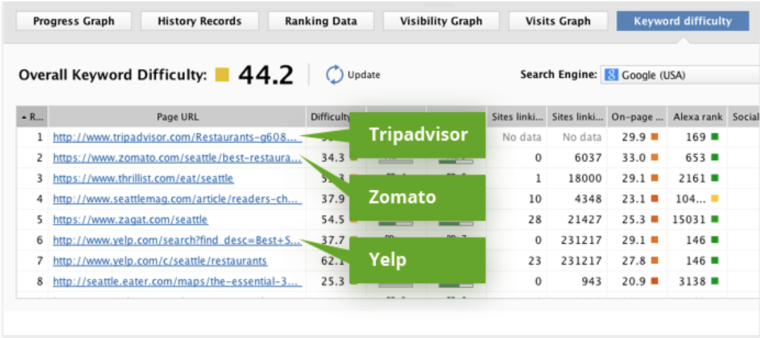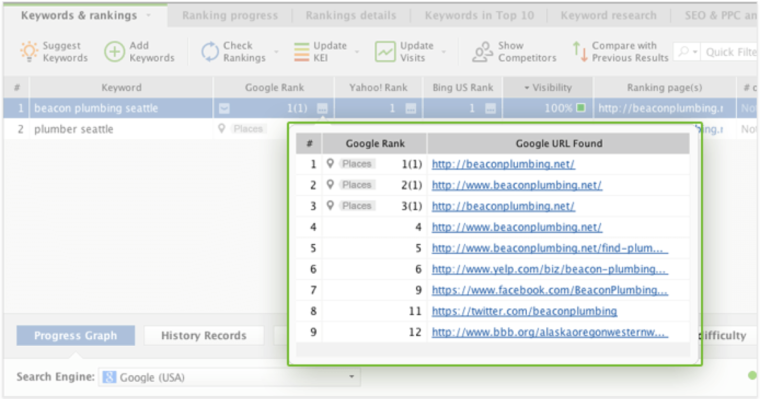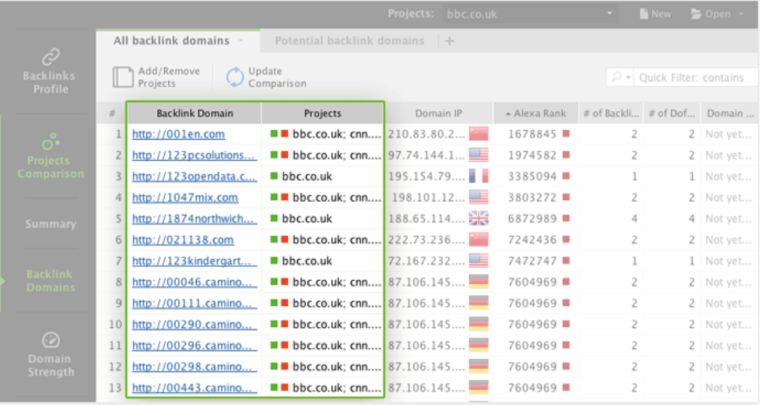

A significant shakeup in local search occurred on August 7th when Google made the decision to reduce the familiar local pack from seven listings to three listings.
On that day, search marketers were left with the question: how can I stay competitive in local search?
I’m here to help answer that question.
First, just so we’re on the same page, I will go over the most notable changes that have occurred in local search since August 7th.
Recent Changes to Google Local Search
In addition to the names of businesses, Google’s local 7-pack also contained addresses and phone numbers. Now, phone numbers are gone, but addresses remain.
As a benefit to searchers, store hours are displayed (when available) in place of phone numbers, which helps people know know if a business they are looking up is about to close soon.
*There is a caveat here that we’ll dive into more later, but it involves Schema markup*.
Additional information about a business will be displayed if a person clicks on the business’s name. This will open an expanded view with the full name, address, and phone number (NAP).
Google’s old local pack contained links to Google+ business pages — those are now gone. Instead, Google is more prominently featuring a link to the business’s own website.
This is a benefit to businesses since it will help drive traffic to their website, the center of any search marketing strategy, instead of a social media page.
When it comes to reviews and review stars there is no change there. Those are displayed as they always were since they are more of a Google Maps integration than a Google+ integration — and Maps is still very much a focal point of local search.
Besides Maps, what still matters in local search in light of these changes? That’s what we’ll go over next.
Here’s What Now Matters in Local Search
Now that we’re up to speed on local search, let’s distill the above section down into a few essential bullet points:
- The 7-pack is now a 3-pack
- Google Maps is still hugely important
- Google+ is less of a focus in local search
- Websites are more visible
- Phone numbers are not as visible, but still easily found
- No changes to how reviews and review stars are displayed
I’ll admit, going from 3 to 7 listings is concerning. It’s even more concerning when you consider the fact that your listing is almost always going to be displayed alongside competitors — even when opened in expanded view.
Again, I’ll pose the question: how can you stay competitive in local search?
Without a doubt, you’ll have to make some adjustments to your local search strategy.
Adjusting Your Local Search Marketing Objective
If you’re trying to compete for a spot in the new local 3-pack, I’ll tell you right now that’s not the best way to go. That’s because the local 3-pack is dependent on a person’s location.
Results in the local pack are ranked according to proximity of the searcher. However, there is a very clear option to open an expanded view of more businesses.
That’s where it gets more competitive. That’s where people aren’t just picking the first option presented to them — they’re searching for information to make a decision.
That being said, I’ll tell you what one of your new local search marketing goals should be.
Primary Objective: Feed Google With Information About Your Business
One of the most fundamental goals of not only search marketing, but marketing in general, is to give people enough information to decide that your business is the one they need.
Where do people get that information from these days? Google Search.
This is where it becomes clear that your objective should be to feed Google with the information you want it to provide to people looking for your business.
There a number of ways to do that. Here’s a list, and then I’ll go over each of these in detail:
- Your website’s on-page content
- Your website’s off-page signals
- Google Maps
- Local reviews
- Offline marketing
- Build local backlinks
Optimizing Your Website’s On-Page Content for Local Search
When Google crawls your website it’s important that it’s able to figure out where you’re physically located.
Recommendation: Create individual pages for each location, or each city in which you service customers.
In order to rank for individual cities and locations, it’s important that the text on each of these location pages is completely unique. Avoid recycling the same copy for each page.
In addition, each of these pages should contain embedded Google maps and Schema markup on the address on the address, company name, and telephone number.
Here’s more information on how to implement schema markup for a local business: http://schema.org/Organization.
Use Google’s Structured Data Testing Tool to ensure that the Schema markup validates.
Optimizing Your Website’s Off-Page Signals for Local Search
On-page optimization can only get you so far. The be truly competitive your off-page signals need to be strong as well. This involves building a strong presence on local directories like YellowPages.com, which contributes to your site’s local ranking potential.
Using a tool like SEO PowerSuite you can find the most influential local directories in your niche. With the Rank Tracker component you’ll find 10 highest ranking directories for each of your target keywords in the Keyword Difficulty table.
Here is an example:

Consistency is Key
When building these local citations it cannot be stressed enough how important it is that the information is consistent. The name, address, and phone number of the business is consistent across all listings — this helps send a clear message to Google about where your business is.
Monitor Your Listings
Once you have narrowed down the directories most relevant to your business, make it your goal to get your business listed in each of those directories.
Submit your business to these directories that are currently ranking high for your keyword, but don’t just get a listing and forget about it.
In order to get the most SEO value out of it, another goal should be to get your listing ranking for one of your target keywords, or at least your business name.
Using the Rank Tracker component of SEO PowerSuite you can track how rankings change for your different listings.
With Rank Tracker, you can track all of your listings by doing the following: enter the URLs of the pages with your listing in Preferences -> Alternative URLs, alongside with your main project URL.
When checking your rankings, Rank Tracker will go through Google search results and see where your specified directory pages are ranking.


Optimizing Your Google Maps Listing
When your business shows up in the local 3-pack, the presentation of your Maps listing is paramount.
When comparing businesses in Google Maps, what information does a person have to work with? They have the address, phone number, review stars, and store hours.
Address & Phone Number
When submitting your Google Maps listing you’re asked for the address and phone number, so that is already taken care of.
Star Ratings and Reviews
Next comes earning a favorable star rating and some nicely worded reviews. This should be an on-going strategy that involves providing good service and asking satisfied customers to leave a review for you.
Don’t be afraid to ask for a review. If the person isn’t comfortable with leaving one, then you have the opportunity to ask why and perhaps make their experience better before they go and leave a negative review.
It’s also important to note here that review score are even more crucial now that Google has added the option to use that as a filter for Maps results.
Store Hours
Your store hours could make the decision as to whether or not someone visits your business. If you’re open later or earlier than a competitor, that’s important information for someone to know.
At this time, it looks like even if store hours are in your Google+ business page, Google will only display store hours if you have the correct schema markup on your site.
Here is some more information about how to implement store hours schema markup.
Earn Local Reviews on Sites Like Yelp, TripAdvisor, Etc.
Do you know what gained visibility in the SERPs after August 7th? Local review sites!
With the local pack going from 3 to 7, and Google+ being removed, there’s a greater opportunity for local review sites to rank on the first page.
Now it’s time to strongly consider what a person would find if they landed on a Yelp page about your business.
Whether you’re comfortable with straight up asking for reviews or not, the fact is building a presence on these sites is even more important than it was before.
Earning Links Through Offline Marketing
If you think that offline marketing doesn’t affect your business’s online presence, then you’re missing out on a wealth of opportunities.
Offline marketing definitely has the ability to impact your online presence. Here are a few ideas of how you can positively influence your local search presence through offline tactics.
Getting Elusive .Edu Links
It’s no secret that Google puts additional weight on .edu links as a ranking signal, but going out and getting a .edu is easier said than done.
I have personally seen clients earn multiple .edu links through offline marketing via local colleges and Universities. Sponsoring things like things like bursaries, scholarships, school events, and career fairs, can often lead to a link on the school’s website.
That’s one way to earn .edu links, but I would be remiss without recommending that you only sponsoring schools you personally care about. The same goes for other sponsorship opportunities.
Support Local Charities and Non-Profit Organizations
Extending your support to local charities and non-profits is a great way to build offline connections that could lead to local links.
Support doesn’t always involve money, it could also be time, supplies, expertise, or anything of value your business has to offer. If you are already engaging in these kinds of activities, don’t be shy to ask each organization’s website.
Join a Local Chamber of Commerce
Joining a Chamber of Commerce is almost a surefire way to get a link back to your website that’s locally relevant. You can leave it at that, or you can get more out of the experience.
Through attending events hosted by the Chamber you could make connections the lead to anything from new business to new links down the road.
Build Local Backlinks
Technically, what we have been doing throughout most of the off-page sections is building local backlinks, but there are still some ideas we haven’t covered.
What are they? That’s for you to find out. Using a tool like SEO SpyGlass you can analyze your competitor’s backlinks and quickly compare them to yours.
Using the SEO SpyGlass and Domain Comparison components you can see where your top local competitors are getting their backlinks from, and use their ideas for your own link building strategies.
You can also compare competitors’ links against each other. The tool will find backlinks pointing to each of the competitor websites, then you can switch to the comparison table to see what the sites have in common and how they differ.
Here is an example:

From there you will get an idea of what kinds of backlinks are contributing to your competitors’ rankings, and which of those links may be viable for you to attain as well.
In Conclusion
I started off talking about the local 3-pack, but truly the scope is more broad than that. It is not just about appearing in the 3-pack, but how you appear versus your competitors.
In addition, staying competitive in local search involves getting your business to appear in prime first page real estate now occupied by review sites and directory sites.
[“source-searchenginejournal”]

